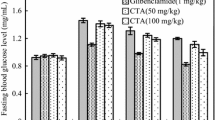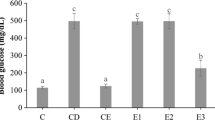Abstract
In traditional medicine, Eucalyptus globulus (eucalyptus) was used for the treatment of diabetes mellitus. Hyperglycemia in diabetes has been associated with increased formation of reactive oxygen species (ROS) and oxidative damage to tissue compounds. The aim of this study was to evaluate the effects of eucalyptus in the diet (20 g/Kg) and drinking water (2.5 g/L) on lipid peroxidation, protein oxidation and antioxidant power in plasma and liver homogenate, as well as glycated-Hb (HbA1C) of blood in streptozotocin-induced diabetic rats for a period of 4 weeks. Diabetes induced in rats by a single intraperitoneal injection of streptozotocin (STZ, 65 mg/Kg). At the end of the treatment period, the level of plasma glucose, plasma and liver malondialdehyde (MDA, the main product of lipid peroxidation), protein carbonyl (PC, one of the protein oxidation products) and HbA1C increased and ferric reducing antioxidant power (FRAP) decreased in diabetic rats compared to normal rats. Eucalyptus administration for 4 weeks caused a significant decrease in the plasma glucose levels, plasma and liver MDA, PC and HbA1C, also a concomitant increase in the levels of FRAP in diabetic treated rats. In conclusion, the present study showed that eucalyptus posses antioxidant activities. Eucalyptus probably restores antioxidant power, due to the improved hyperglycemia in streptozotocin-induced diabetic rats.
Similar content being viewed by others
References
The Expert Committee on Diagnosis and Classification of Diabetes Mellitus. Report of the expert committee on diagnosis and classification of diabetes mellitus. Diabetes Care 2003;26:S5–S20.
Wild S, Roglic K, Green A, Sicree R, King H. Global prevalence of diabetes, Estimation for the year 2003 and projections for 2030. Diabetes Care 2004;27:1047–1053.
Nammi S, Boini MK, Lodagala DS, Behara RBS. The juice of fresh leaves of Catharanthus rosesus Linn reduces blood glucose in normal and alloxan diabetic rats. BMC Complement Altern Med 2003;3:1–4.
Mohamed AK, Bierhaus A, Schiekofer S, Tristschler H, Ziegler H, Nawroth PP. The role of oxidative stress and NF-β activation in late diabetic complication. Biofactors 1999;10:171–179.
Baynes JW. Role of oxidative stress in development of complications in diabetes. Diabetes 1991;40:405–412.
Booth A, Khalifah R, Tood P, Hudson B. Invitro kinetic studies of formation antigenic advanced glycation end product (AGEs): Novel inhibition of post-amadori glycation pathway. J Biol Chem 1997;272:5430–5437.
Vlassara H, Palace M. Diabetes and advanced glycation end products. J Intern Med 2001;251:87–101.
Gallou G, Ruelland A, Legras B, Maugendre D, Allannic H, Cloarec L. Plasma malondialdehyde in type 1 and type 2 diabetic patients. Clin Chim Acta 1993;214:227–234.
Vandam PS, Bravenboer B. Oxidative stress and antioxidant treatment in diabetic neuropathy. Neurosci Res Commun 1997;21:41–48.
Telci A, Cakatay U, Salman S, Satman I, Sivas A. Oxidative protein damage in early stage type 1 diabetic patients. Diabetes Research Clin practice 2000;50:213–223.
Maxwell SR, Thopson H, Sandler D, Leguen C, Baxter MA, Thrope GH, Jones AF, Barnett AH. Antioxidant status in patient with uncomplicated insulin-dependent and noninsulin-dependent diabetes mellitus. Eur J Clin Invest 1997;27:484–490.
Santini SA, Marra G, Giardina B, Cotroneo P, Mordenet A, Martorana GE, Manto A, Ghirlanda G. Defective plasma antioxidant defenses and enhanced susceptibility to lipid peroxidation in uncomplicated IDDM. Diabetes 1997;46:1853–1858.
Grover JK, Yadav S, Vats V. Medicinal plants of India with antidiabetic potential. J Ethnophamacol 2002;81:81–100.
Yeh GY, Eisenberg DM, Kaptchuk TJ, Philips RS. Systematic review of herbs and dietary supplements for glycemic control in diabetes. Diabetes Care 2003;26:1277–1294.
Alarcon-Aguilara FJ, Roman-Ramos R, Perez-Gutierrez S. Study of the anti-hyperglycemia effect of plants used as antidiabetics. J Ethnopharmacol 1998;61:101–110.
Chattopadhyay RR. A Comparative evaluation of some blood glucose lowering agents of plant origin. J Ethnopharmacol 1999;67:367–372.
Gray AM, Flatt PR. Antihyperglycemic actions of Eucalyptus globulus (Eucalyptus) are associated with pancreatic and extra-pancreatic effects in mice. J Nutr 1998;128:2319–2323.
Swanston-Flatt SK, Day C, Bailey CJ, Flatt PR. Traditional plant treatment for diabetes: Studies in normal and streptozotocin diabetic mice. Diabetologia 1990;33:462–464.
Evans P, Lyras L, Halliwell B. Measurement of protein carbonyls in human brain tissue. Clin Chim Acta 1982;93:145–156.
Bisse E, Abraham EC. New less temperature-sensitive micro chromatographic method for separation and quantitation of glycosylated hemoglobin using a non cyanide buffer system. J Chromatog 1985;344:81–91.
Uchiyama M, Mihara M. Determination of malonaldehyde precursor in tissues by thiobarbituric acid test. Anal Biochem 1978;86:271–278.
Benzie IFF, Strain JJ. The ferric reducing ability of plasma (FRAP) as a measure of “antioxidant power”: the FRAP assay. Analytical Biochem 1996;239:70–76
Benzie IFF, Strain JJ. The ferric reducing/antioxidant power: Direct measured of the total antioxidant activity of biological fluids and modified version for simulation measurement of total antioxidant power and ascorbic acid concentration. Methods Enzymol 1999;299:15–27.
Bradford MM. A rapid and sensitive method for the quantitation of microgram quantities of protein utilizing the principle of protein-dye binding. Anal Biochem 1976;72:248–254.
Reznick AZ, Packer L. Oxidative damage to proteins: spectrophotometric method for carbonyl assay. Methods Enzymol 1994;233:357–363.
Szkudelski T. The mechanism of alloxan and streptozotocin action in β-cells of the rat pancreas. Physiol Res 2001;50:536–546.
Ozturk Y, Altan VM, Yildizoglu A. Effects of experimental diabetes and insulin on smooth muscle functions. Pharmacol Rev 1996;48:69–112.
Klein R. Hyperglycemia and microvascular and macrovascular disease in diabetes. Diabetes Care 1995;18:258–268.
Singh R, Barden A, Mori T, Bellin L. Advanced glycation endproducts: a review. Diabetologia 2001;44:129–146.
Paul R, Bailey A. Glycation of collagen: the basis of its central role in the late complications of aging and diabetes. Int J Biochem Cell Biol 1996;28:1297–1310.
Sheela GL, Augusti KT. Antidiabetic effect of S-allyl cysteine sulphoxide isolated from garlic Allium sativium. Ind J Exp Biol 1992;30:523–526.
Bunn HG, Gabby KH, Gallop PM. The glycosylation of hemoglobin: relevance to diabetes mellitus. Science 1978;200:21–27.
Bravi MR, Armiento A, Laurenti O, Cassano-Faldetta M, De Luca O, Morettia A, De Mattia G. Insulin decreases intracellular oxidative stress in patient with type 2 diabetes mellitus. Metab Clin Exp 2006;55:591–696.
Jain SK, Robert M, John JH. Erythrocyte membrane lipid peroxidation and glycosylated hemoglobin in diabetes. Diabetes 1989;38:1539–1543.
Bayanes JW, Thrope SR. Role of oxidative stress in diabetic complications: a new perspective on an old paradigm. Diabetes 1999;48:1–9.
Levy U, Zaltzber H, Ben-Amotz A, Kanter Y, Aviram M. β-carotene affects antioxidant status in noninsulin-dependent diabetes mellitus. Pathophysiol 1999;6:157–161.
Motilla P, Vargas JF, Munoz De Agueda MC, Valdelvira ME, Cabrera ES. Oxidative stress in diabetic rats induced by streptozotocin: Preventive effects of melatonin. J Pineal Res 1998;25:94–100.
Vijayakumar M, Govindrajan R, Rao CHC, Shirwaikar A, Mehrota S, Pushpangadan P. Action of Hygrophila auriculata against streptozotocin-induced oxidative stress. J Ethnophamacol 2006;104:356–361.
Vigo E, Cepeda A, Gualillo O, Perez-Fernandez R. In-vitro anti-inflammatory effect of Eucalyptus globulus and Thymus vulgaris: nitric oxide inhibition in J774A.1 murine macrophages. J Pharm Pharmacol 2004;56:257–263.
Yun BS, Lee IK, Kim JP, Chung SH, Shim GS, Yoo ID. Lipid peroxidation inhibitory activity of some constituents isolated from the stem bark of Eucalyptus globulus. Arch Pharm Res 2000;23:147–150.
Seghrouchi I, Dari J, Bannier E, Riviere J, Calmard P, Garcia I, Orgiazzi J, Revol A. Oxidative stress parameters in type 1, type 2 and insulin-treated type 2 diabetes mellitus; insulin treatment efficacy. Clin Chim Acta 2002;321:89–96.
Cakatay U, Kayali R. The evaluation of altered redox status in plasma and mitochondria of acute and chronic diabetic rats. Clin Biochem 2006;39:907–912.
Telci A, Cakatay U, Kayali R, Erdogan C, Orhan Y, Sivas A, Akcay T. Oxidative protein damage in plasma of type 2 diabetic patients. Horm Metab Res 2000;32:40–43.
Dominguez C, Ruiz E, Gussinye M, Carrascosa A. Oxidative stress at onset and in early stages of type 1 diabetes in children and adolescents. Diabetes Care 1998;21:1736–1742.
Author information
Authors and Affiliations
Corresponding author
Rights and permissions
About this article
Cite this article
Nakhaee, A., Bokaeian, M., Saravani, M. et al. Attenuation of oxidative stress in streptozotocin-induced diabetic rats by Eucalyptus globulus . Indian J Clin Biochem 24, 419–425 (2009). https://doi.org/10.1007/s12291-009-0075-1
Published:
Issue Date:
DOI: https://doi.org/10.1007/s12291-009-0075-1




